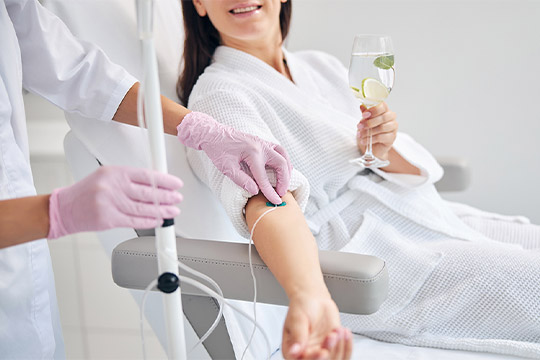In recent years, the pursuit of radiant, youthful skin has led many to explore advanced treatments like glutathione IV therapy. Known for its powerful antioxidant properties, glutathione has gained attention for its potential benefits in skin repair and rejuvenation. For those considering this treatment, particularly in regions like IV drip Dubai , understanding its effects on skin health is essential. This article delves into the science behind glutathione IV drips, their role in skin repair, and what to expect from the treatment.
What is Glutathione? and Its Role in Skin Health
Glutathione is a naturally occurring tripeptide composed of three amino acids: cysteine, glycine, and glutamic acid. It is one of the body’s most potent antioxidants, playing a crucial role in neutralizing free radicals, detoxifying the body, and supporting immune function. Over time, factors like UV exposure, pollution, stress, and aging deplete glutathione levels, leading to oxidative stress, which accelerates skin damage.
How Glutathione Affects Skin Repair?
The skin’s ability to repair itself depends largely on cellular health and antioxidant defense mechanisms. Glutathione contributes to skin repair in several ways:
- Neutralizing Free Radicals – By scavenging harmful free radicals, glutathione prevents oxidative damage that leads to premature aging, wrinkles, and hyperpigmentation.
- Reducing Melanin Production – Glutathione inhibits tyrosinase, an enzyme involved in melanin synthesis, which helps lighten dark spots and even out skin tone.
- Promoting Collagen Synthesis – It supports collagen production, improving skin elasticity and reducing fine lines.
- Detoxification – By aiding liver function, glutathione helps eliminate toxins that contribute to skin dullness and breakouts.

Glutathione IV Drip vs. Oral Supplements
While oral glutathione supplements are widely available, their effectiveness is limited due to poor bioavailability. The digestive system breaks down much of the glutathione before it reaches the bloodstream. In contrast, intravenous (IV) administration ensures near-complete absorption, delivering high concentrations directly into the circulatory system for optimal results.
Benefits of IV Glutathione for Skin Repair
- Faster Results – Since IV therapy bypasses the digestive system, the effects are more immediate compared to oral supplements.
- Higher Potency – IV drips provide a concentrated dose, making them more effective for skin brightening and repair.
- Longer-Lasting Effects – Regular IV sessions can sustain elevated glutathione levels, promoting prolonged skin benefits.
Scientific Evidence Supporting Glutathione IV for Skin Repair
Several studies highlight glutathione’s role in improving skin health:
- A study published in the Journal of Clinical and Aesthetic Dermatology found that glutathione supplementation led to significant skin lightening in participants with melasma.
- Research in Biomedicine & Pharmacotherapy demonstrated that glutathione reduces oxidative stress, which is linked to skin aging and damage.
- Another study in the Indian Journal of Dermatology reported that glutathione, when administered intravenously, improved skin clarity and reduced hyperpigmentation.
While these findings are promising, individual results may vary based on factors like dosage, frequency of treatment, and overall skin condition.
Who Can Benefit from Glutathione IV Therapy?
Glutathione IV drips may be particularly beneficial for individuals dealing with:
- Hyperpigmentation – Dark spots, melasma, and uneven skin tone.
- Premature Aging – Fine lines, wrinkles, and loss of elasticity.
- Acne Scarring – Post-inflammatory hyperpigmentation and skin texture issues.
- Dull, Tired Skin – Lack of radiance due to oxidative stress and toxin buildup.
However, it is essential to consult a healthcare professional before starting any IV therapy to ensure safety and suitability.
Potential Side Effects and Considerations
Glutathione IV drips are generally considered safe when administered by a qualified professional. However, some individuals may experience mild side effects, such as:
- Nausea or dizziness – Usually temporary and subsides quickly.
- Allergic reactions – Rare but possible in sensitive individuals.
- Mineral imbalances – High doses may affect zinc and selenium levels.
To minimize risks, it is crucial to undergo treatment under medical supervision and adhere to recommended dosages.
How Often Should You Get a Glutathione IV Drip for Skin Repair?
The frequency of treatment depends on individual goals and skin concerns. A typical protocol may include:
- Initial Phase – Weekly sessions for 4-6 weeks to build up glutathione levels.
- Maintenance Phase – Bi-weekly or monthly sessions to sustain results.
Consistency is key, as glutathione’s effects are cumulative. However, overuse should be avoided to prevent potential side effects.
Conclusion
Glutathione IV therapy offers a promising solution for skin repair, addressing concerns like hyperpigmentation, aging, and dullness through its potent antioxidant and detoxifying effects. While oral supplements have limited efficacy, IV administration ensures maximum absorption and visible results. For those exploring advanced skin rejuvenation options, consulting a qualified practitioner is essential to determine the best approach.






Comments